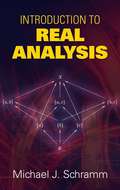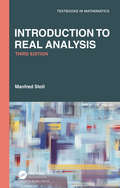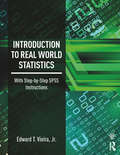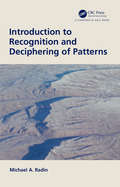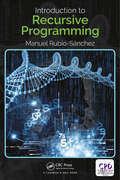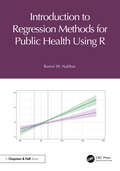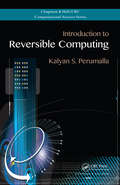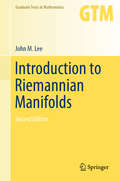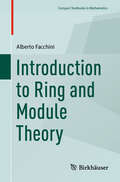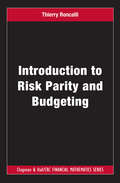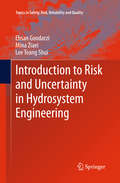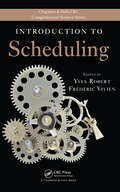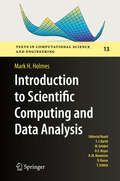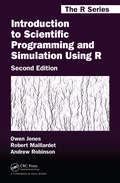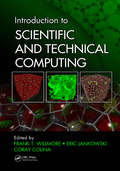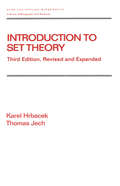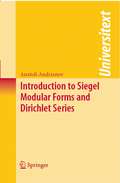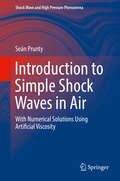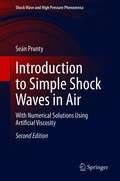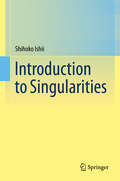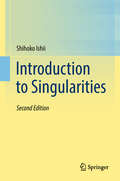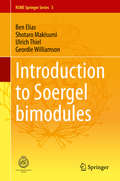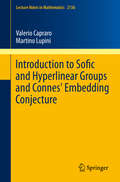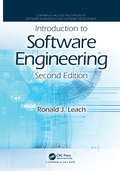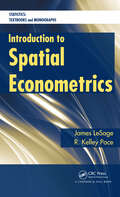- Table View
- List View
Introduction to Real Analysis
by Michael J. SchrammThis text forms a bridge between courses in calculus and real analysis. It focuses on the construction of mathematical proofs as well as their final content. Suitable for upper-level undergraduates and graduate students of real analysis, it also provides a vital reference book for advanced courses in mathematics.The four-part treatment begins with an introduction to basic logical structures and techniques of proof, including discussions of the cardinality concept and the algebraic and order structures of the real and rational number systems. Part Two presents in-depth examinations of the completeness of the real number system and its topological structure. Part Three reviews and extends the previous explorations of the real number system, and the final part features a selection of topics in real function theory. Numerous and varied exercises range from articulating the steps omitted from examples and observing mechanical results at work to the completion of partial proofs within the text.
Introduction to Real Analysis (Textbooks in Mathematics)
by Manfred StollThis classic textbook has been used successfully by instructors and students for nearly three decades. This timely new edition offers minimal yet notable changes while retaining all the elements, presentation, and accessible exposition of previous editions. A list of updates is found in the Preface to this edition. This text is based on the author’s experience in teaching graduate courses and the minimal requirements for successful graduate study. The text is understandable to the typical student enrolled in the course, taking into consideration the variations in abilities, background, and motivation. Chapters one through six have been written to be accessible to the average student, w hile at the same time challenging the more talented student through the exercises. Chapters seven through ten assume the students have achieved some level of expertise in the subject. In these chapters, the theorems, examples, and exercises require greater sophistication and mathematical maturity for full understanding. In addition to the standard topics the text includes topics that are not always included in comparable texts. Chapter 6 contains a section on the Riemann-Stieltjes integral and a proof of Lebesgue’s t heorem providing necessary and sufficient conditions for Riemann integrability. Chapter 7 also includes a section on square summable sequences and a brief introduction to normed linear spaces. C hapter 8 contains a proof of the Weierstrass approximation theorem using the method of aapproximate identities. The inclusion of Fourier series in the text allows the student to gain some exposure to this important subject. The final chapter includes a detailed treatment of Lebesgue measure and the Lebesgue integral, using inner and outer measure. The exercises at the end of each section reinforce the concepts. Notes provide historical comments or discuss additional topics.
Introduction to Real World Statistics: With Step-By-Step SPSS Instructions
by Edward T. Vieira Jr.Introduction to Real World Statistics provides students with the basic concepts and practices of applied statistics, including data management and preparation; an introduction to the concept of probability; data screening and descriptive statistics; various inferential analysis techniques; and a series of exercises that are designed to integrate core statistical concepts. The author’s systematic approach, which assumes no prior knowledge of the subject, equips student practitioners with a fundamental understanding of applied statistics that can be deployed across a wide variety of disciplines and professions. Notable features include: short, digestible chapters that build and integrate statistical skills with real-world applications, demonstrating the flexible usage of statistics for evidence-based decision-making statistical procedures presented in a practical context with less emphasis on technical jargon early chapters that build a foundation before presenting statistical procedures SPSS step-by-step detailed instructions designed to reinforce student understanding real world exercises complete with answers chapter PowerPoints and test banks for instructors.
Introduction to Recognition and Deciphering of Patterns
by Michael A. RadinIntroduction to Recognition and Deciphering of Patterns is meant to acquaint STEM and non-STEM students with different patterns, as well as to where and when specific patterns arise. In addition, the book teaches students how to recognize patterns and distinguish the similarities and differences between them. Patterns, such as weather patterns, traffic patterns, behavioral patterns, geometric patterns, linguistic patterns, structural patterns, digital patterns, and the like, emerge on an everyday basis, . Recognizing patterns and studying their unique traits are essential for the development and enhancement of our intuitive skills and for strengthening our analytical skills. Mathematicians often apply patterns to get acquainted with new concepts--a technique that can be applied across many disciplines. Throughout this book we explore assorted patterns that emerge from various geometrical configurations of squares, circles, right triangles, and equilateral triangles that either repeat at the same scale or at different scales. The book also analytically examines linear patterns, geometric patterns, alternating patterns, piecewise patterns, summation-type patterns and factorial-type patterns. Deciphering the details of these distinct patterns leads to the proof by induction method, and the book will also render properties of Pascal’s triangle and provide supplemental practice in deciphering specific patterns and verifying them. This book concludes with first-order recursive relations: describing sequences as recursive relations, obtaining the general solution by solving an initial value problem, and determining the periodic traits. Features • Readily accessible to a broad audience, including those with limited mathematical background • Especially useful for students in non-STEM disciplines, such as psychology, sociology, economics and business, as well as for liberal arts disciplines and art students.
Introduction to Recursive Programming
by Manuel Rubio-SanchezRecursion is one of the most fundamental concepts in computer science and a key programming technique that allows computations to be carried out repeatedly. Despite the importance of recursion for algorithm design, most programming books do not cover the topic in detail, despite the fact that numerous computer programming professors and researchers in the field of computer science education agree that recursion is difficult for novice students. Introduction to Recursive Programming provides a detailed and comprehensive introduction to recursion. This text will serve as a useful guide for anyone who wants to learn how to think and program recursively, by analyzing a wide variety of computational problems of diverse difficulty. It contains specific chapters on the most common types of recursion (linear, tail, and multiple), as well as on algorithm design paradigms in which recursion is prevalent (divide and conquer, and backtracking). Therefore, it can be used in introductory programming courses, and in more advanced classes on algorithm design. The book also covers lower-level topics related to iteration and program execution, and includes a rich chapter on the theoretical analysis of the computational cost of recursive programs, offering readers the possibility to learn some basic mathematics along the way. It also incorporates several elements aimed at helping students master the material. First, it contains a larger collection of simple problems in order to provide a solid foundation of the core concepts, before diving into more complex material. In addition, one of the book's main assets is the use of a step-by-step methodology, together with specially designed diagrams, for guiding and illustrating the process of developing recursive algorithms. Furthermore, the book covers combinatorial problems and mutual recursion. These topics can broaden students' understanding of recursion by forcing them to apply the learned concepts differently, or in a more sophisticated manner. The code examples have been written in Python 3, but should be straightforward to understand for students with experience in other programming languages. Finally, worked out solutions to over 120 end-of-chapter exercises are available for instructors.
Introduction to Regression Methods for Public Health Using R
by Ramzi W. NahhasIntroduction to Regression Methods for Public Health Using R teaches regression methods for continuous, binary, ordinal, and time-to-event outcomes using R as a tool. Regression is a useful tool for understanding the associations between an outcome and a set of explanatory variables, and regression methods are commonly used in many fields, including epidemiology, public health, and clinical research. The focus of this book is on understanding and fitting regression models, diagnosing model fit, and interpreting and writing up results. Examples are drawn from public health and clinical studies. Designed for students, researchers, and practitioners with a basic understanding of introductory statistics, this book teaches the basics of regression and how to implement regression methods using R, allowing the reader to enhance their understanding and begin to grasp new concepts and models.The text includes an overview of regression (Chapter 2); how to examine and summarize the data (Chapter 3), simple (Chapter 4) and multiple (Chapter 5) linear regression; binary, ordinal, and conditional logistic regression, and log-binomial regression (Chapter 6); Cox proportional hazards regression (survival analysis) (Chapter 7); handling data arising from a complex survey design (Chapter 8); and multiple imputation of missing data (Chapter 9). Each chapter closes with a comprehensive set of exercises.Key Features: Comprehensive coverage of the most commonly used regression methods, as well as how to use regression with complex survey data or missing data Accessible to those with only a first course in statistics Serves as a course textbook, as well as a reference for public health and clinical researchers seeking to learn regression and/or how to use R to do regression analyses Includes examples of how to diagnose the fit of a regression model Includes examples of how to summarize, visualize, table, and write up the results Includes R code to run the examples
Introduction to Reversible Computing (Chapman & Hall/CRC Computational Science #19)
by Kalyan S. PerumallaCollecting scattered knowledge into one coherent account, this book provides a compendium of both classical and recently developed results on reversible computing. It offers an expanded view of the field that includes the traditional energy-motivated hardware viewpoint as well as the emerging application-motivated software approach. It explores up-and-coming theories, techniques, and tools for the application of reversible computing. The topics covered span several areas of computer science, including high-performance computing, parallel/distributed systems, computational theory, compilers, power-aware computing, and supercomputing.
Introduction to Riemannian Manifolds: An Introduction To Curvature (Graduate Texts in Mathematics #176)
by John M. LeeThis text focuses on developing an intimate acquaintance with the geometric meaning of curvature and thereby introduces and demonstrates all the main technical tools needed for a more advanced course on Riemannian manifolds. It covers proving the four most fundamental theorems relating curvature and topology: the Gauss-Bonnet Theorem, the Cartan-Hadamard Theorem, Bonnet’s Theorem, and a special case of the Cartan-Ambrose-Hicks Theorem.
Introduction to Ring and Module Theory (Compact Textbooks in Mathematics)
by Alberto FacchiniThis textbook is designed for a first course in ring theory, module theory and category theory. Written following several decades of teaching experience, it stands out with its clear and engaging style, featuring thorough explanations and attention to detail. Carefully selected exercises encourage active learning and problem-solving. The textbook integrates elementary category theory with basic concepts and examples developed throughout the course. Although the primary focus is on rings and modules, relevant notions for other algebraic structures, such as groups and semigroups, are also discussed. Thus, this book aims at introducing students to noncommutative rings and modules within a broader algebraic context. Aimed at advanced undergraduates or master students in mathematics, this textbook is suitable both for use in the classroom and self-study. Whereas the first part of the book covers a basic course in ring and module theory, the latter part includes optional deepening topics.
Introduction to Risk Parity and Budgeting (Chapman and Hall/CRC Financial Mathematics Series)
by Thierry RoncalliAlthough portfolio management didn't change much during the 40 years after the seminal works of Markowitz and Sharpe, the development of risk budgeting techniques marked an important milestone in the deepening of the relationship between risk and asset management. Risk parity then became a popular financial model of investment after the global fina
Introduction to Risk and Uncertainty in Hydrosystem Engineering
by Ehsan Goodarzi Mina Ziaei Lee Teang ShuiWater engineers require knowledge of stochastic, frequency concepts, uncertainty analysis, risk assessment, and the processes that predict unexpected events. This book presents the basics of stochastic, risk and uncertainty analysis, and random sampling techniques in conjunction with straightforward examples which are solved step by step. In addition, appropriate Excel functions are included as an alternative to solve the examples, and two real case studies is presented in the last chapters of book.
Introduction to Scheduling (Chapman & Hall/CRC Computational Science)
by Yves Robert Frédéric VivienFull of practical examples, Introduction to Scheduling presents the basic concepts and methods, fundamental results, and recent developments of scheduling theory. With contributions from highly respected experts, it provides self-contained, easy-to-follow, yet rigorous presentations of the material.The book first classifies scheduling problems and
Introduction to Scientific Computing and Data Analysis
by Mark H. HolmesThis textbook provides and introduction to numerical computing and its applications in science and engineering. The topics covered include those usually found in an introductory course, as well as those that arise in data analysis. This includes optimization and regression based methods using a singular value decomposition. The emphasis is on problem solving, and there are numerous exercises throughout the text concerning applications in engineering and science. The essential role of the mathematical theory underlying the methods is also considered, both for understanding how the method works, as well as how the error in the computation depends on the method being used. The MATLAB codes used to produce most of the figures and data tables in the text are available on the author's website and SpringerLink.
Introduction to Scientific Programming and Simulation Using R (Chapman & Hall/CRC The R Series)
by Owen Jones Andrew Robinson Robert MaillardetLearn How to Program Stochastic ModelsHighly recommended, the best-selling first edition of Introduction to Scientific Programming and Simulation Using R was lauded as an excellent, easy-to-read introduction with extensive examples and exercises. This second edition continues to introduce scientific programming and stochastic modelling in a clear,
Introduction to Scientific and Technical Computing
by FRANK T. WILLMORE, ERIC JANKOWSKI AND CORAY COLINACreated to help scientists and engineers write computer code, this practical book addresses the important tools and techniques that are necessary for scientific computing, but which are not yet commonplace in science and engineering curricula. This book contains chapters summarizing the most important topics that computational researchers need to know about. It leverages the viewpoints of passionate experts involved with scientific computing courses around the globe and aims to be a starting point for new computational scientists and a reference for the experienced. Each contributed chapter focuses on a specific tool or skill, providing the content needed to provide a working knowledge of the topic in about one day. While many individual books on specific computing topics exist, none is explicitly focused on getting technical professionals and students up and running immediately across a variety of computational areas.
Introduction to Set Theory (Pure and Applied Mathematics #220)
by Karel Hrbacek Thomas JechThoroughly revised, updated, expanded, and reorganized to serve as a primary text for mathematics courses, Introduction to Set Theory, Third Edition covers the basics: relations, functions, orderings, finite, countable, and uncountable sets, and cardinal and ordinal numbers. It also provides five additional self-contained chapters, consolidates the material on real numbers into a single updated chapter affording flexibility in course design, supplies end-of-section problems, with hints, of varying degrees of difficulty, includes new material on normal forms and Goodstein sequences, and adds important recent ideas including filters, ultrafilters, closed unbounded and stationary sets, and partitions.
Introduction to Siegel Modular Forms and Dirichlet Series
by Anatoli AndrianovThis is intended for a graduate course on Siegel modular forms, Hecke operators, and related zeta functions. The author's aim is to present a concise and self-contained introduction to an important and developing area of number theory that will serve to attract young researchers to this beautiful field. Topics include: * analytical properties of radial Dirichlet series attached to modular forms of genuses 1 and 2; * the abstract theory of Hecke-Shimura rings for symplectic and related groups; * action of Hecke operators on Siegel modular forms; * applications of Hecke operators to a study of multiplicative properties of Fourier coefficients of modular forms; * Hecke zeta functions of modular forms in one variable and to spinor (or Andrianov) zeta functions of Siegel modular forms of genus two; * the proof of analytical continuation and functional equation (under certain assumptions) for Euler products associated with modular forms of genus two. This text contains a number of exercises and the only prerequisites are standard courses in Algebra and Calculus (one and several variables).
Introduction to Simple Shock Waves in Air
by Seán PruntyThis book provides an elementary introduction to some one-dimensional fluid flow problems involving shock waves in air. The differential equations of fluid flow are approximated by finite difference equations and these in turn are numerically integrated in a stepwise manner. Artificial viscosity is introduced into the numerical calculations in order to deal with shocks. The presentation is restricted to the finite-difference approach to solve the coupled differential equations of fluid flow as distinct from finite-volume or finite-element methods. This text presents the results arising from the numerical solution using Mathcad programming. Both plane and spherical shock waves are discussed with particular emphasis on very strong explosive shocks in air. This text will appeal to students, researchers, and professionals in shock wave research and related fields. Students in particular will appreciate the benefits of numerical methods in fluid mechanics and the level of presentation.
Introduction to Simple Shock Waves in Air: With Numerical Solutions Using Artificial Viscosity (Shock Wave and High Pressure Phenomena)
by Seán PruntyThis book provides an elementary introduction to one-dimensional fluid flow problems involving shock waves in air. The differential equations of fluid flow are approximated by finite difference equations and these in turn are numerically integrated in a stepwise manner, with artificial viscosity introduced into the numerical calculations in order to deal with shocks. This treatment of the subject is focused on the finite-difference approach to solve the coupled differential equations of fluid flow and presents the results arising from the numerical solution using Mathcad programming. Both plane and spherical shock waves are discussed with particular emphasis on very strong explosive shocks in air. This expanded second edition features substantial new material on sound wave parameters, Riemann's method for numerical integration of the equations of motion, approximate analytical expressions for weak shock waves, short duration piston motion, numerical results for shock wave interactions, and new appendices on the piston withdrawal problem and numerical results for a closed shock tube.This text will appeal to students, researchers, and professionals in shock wave research and related fields. Students in particular will appreciate the benefits of numerical methods in fluid mechanics and the level of presentation.
Introduction to Singularities
by Shihoko IshiiThis book is an introduction to singularities for graduate students and researchers. It is said that algebraic geometry originated in the seventeenth century with the famous work Discours de la méthode pour bien conduire sa raison, et chercher la vérité dans les sciences by Descartes. In that book he introduced coordinates to the study of geometry. After its publication, research on algebraic varieties developed steadily. Many beautiful results emerged in mathematicians' works. Most of them were about non-singular varieties. Singularities were considered "bad" objects that interfered with knowledge of the structure of an algebraic variety. In the past three decades, however, it has become clear that singularities are necessary for us to have a good description of the framework of varieties. For example, it is impossible to formulate minimal model theory for higher-dimensional cases without singularities. Another example is that the moduli spaces of varieties have natural compactification, the boundaries of which correspond to singular varieties. A remarkable fact is that the study of singularities is developing and people are beginning to see that singularities are interesting and can be handled by human beings. This book is a handy introduction to singularities for anyone interested in singularities. The focus is on an isolated singularity in an algebraic variety. After preparation of varieties, sheaves, and homological algebra, some known results about 2-dim ensional isolated singularities are introduced. Then a classification of higher-dimensional isolated singularities is shown according to plurigenera and the behavior of singularities under a deformation is studied.
Introduction to Singularities
by Shihoko IshiiThis book is an introduction to singularities for graduate students and researchers.Algebraic geometry is said to have originated in the seventeenth century with the famous work Discours de la méthode pour bien conduire sa raison, et chercher la vérité dans les sciences by Descartes. In that book he introduced coordinates to the study of geometry. After its publication, research on algebraic varieties developed steadily. Many beautiful results emerged in mathematicians’ works. First, mostly non-singular varieties were studied. In the past three decades, however, it has become clear that singularities are necessary for us to have a good description of the framework of varieties. For example, it is impossible to formulate minimal model theory for higher-dimensional cases without singularities. A remarkable fact is that the study of singularities is developing and people are beginning to see that singularities are interesting and can be handled by human beings. This book is a handy introduction to singularities for anyone interested in singularities. The focus is on an isolated singularity in an algebraic variety. After preparation of varieties, sheaves, and homological algebra, some known results about 2-dimensional isolated singularities are introduced. Then a classification of higher-dimensional isolated singularities is shown according to plurigenera and the behavior of singularities under a deformation is studied. In the second edition, brief descriptions about recent remarkable developments of the researches are added as the last chapter.
Introduction to Soergel Bimodules (RSME Springer Series #5)
by Geordie Williamson Ben Elias Shotaro Makisumi Ulrich ThielThis book provides a comprehensive introduction to Soergel bimodules. First introduced by Wolfgang Soergel in the early 1990s, they have since become a powerful tool in geometric representation theory. On the one hand, these bimodules are fairly elementary objects and explicit calculations are possible. On the other, they have deep connections to Lie theory and geometry. Taking these two aspects together, they offer a wonderful primer on geometric representation theory. In this book the reader is introduced to the theory through a series of lectures, which range from the basics, all the way to the latest frontiers of research.This book serves both as an introduction and as a reference guide to the theory of Soergel bimodules. Thus it is intended for anyone who wants to learn about this exciting field, from graduate students to experienced researchers.
Introduction to Sofic and Hyperlinear Groups and Connes' Embedding Conjecture
by Valerio Capraro Martino LupiniThis monograph presents some cornerstone results in the study of sofic and hyperlinear groups and the closely related Connes' embedding conjecture. These notions, as well as the proofs of many results, are presented in the framework of model theory for metric structures. This point of view, rarely explicitly adopted in the literature, clarifies the ideas therein, and provides additional tools to attack open problems. Sofic and hyperlinear groups are countable discrete groups that can be suitably approximated by finite symmetric groups and groups of unitary matrices. These deep and fruitful notions, introduced by Gromov and Radulescu, respectively, in the late 1990s, stimulated an impressive amount of research in the last 15 years, touching several seemingly distant areas of mathematics including geometric group theory, operator algebras, dynamical systems, graph theory, and quantum information theory. Several long-standing conjectures, still open for arbitrary groups, are now settled for sofic or hyperlinear groups. The presentation is self-contained and accessible to anyone with a graduate-level mathematical background. In particular, no specific knowledge of logic or model theory is required. The monograph also contains many exercises, to help familiarize the reader with the topics present.
Introduction to Software Engineering (Chapman & Hall/CRC Innovations in Software Engineering and Software Development Series)
by Ronald J. LeachPractical Guidance on the Efficient Development of High-Quality Software Introduction to Software Engineering, Second Edition equips students with the fundamentals to prepare them for satisfying careers as software engineers regardless of future changes in the field, even if the changes are unpredictable or disruptive in nature. Retaining the same organization as its predecessor, this second edition adds considerable material on open source and agile development models. The text helps students understand software development techniques and processes at a reasonably sophisticated level. Students acquire practical experience through team software projects. Throughout much of the book, a relatively large project is used to teach about the requirements, design, and coding of software. In addition, a continuing case study of an agile software development project offers a complete picture of how a successful agile project can work. The book covers each major phase of the software development life cycle, from developing software requirements to software maintenance. It also discusses project management and explains how to read software engineering literature. Three appendices describe software patents, command-line arguments, and flowcharts.
Introduction to Spatial Econometrics (Statistics: A Series of Textbooks and Monographs)
by James LeSage Robert Kelley PaceAlthough interest in spatial regression models has surged in recent years, a comprehensive, up-to-date text on these approaches does not exist. Filling this void, Introduction to Spatial Econometrics presents a variety of regression methods used to analyze spatial data samples that violate the traditional assumption of independence between observat
